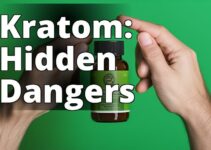Are you aware of the dangers of consuming Amanita Muscaria? This mushroom, commonly known as the fly agaric mushroom, is notorious for its toxic properties. In this article, we will explore in-depth the risks associated with consuming this mushroom, including its physical appearance, toxic properties, symptoms of poisoning, treatment and management, as well as prevention and safety measures.
About the Author
As a mycologist with over a decade of experience in studying wild mushrooms, I have encountered numerous cases of poisoning caused by Amanita Muscaria. My goal is to raise awareness about the dangers of consuming this mushroom and provide readers with essential information on how to stay safe.
Amanita Muscaria Dangers: What You Need to Know to Stay Safe
- Amanita Muscaria is a poisonous mushroom, commonly known as fly agaric.
- It contains toxins like muscimol and ibotenic acid that affect the human body and nervous system.
- Accidental poisoning can cause gastrointestinal and neurological symptoms, and severe and even fatal consequences.
Amanita Muscaria is a mushroom commonly found in Northern Hemisphere forests. It is easily recognizable due to its distinctive red cap with white spots. While it has a long history of cultural and religious use, particularly in northern Europe and Asia, the recreational use of Amanita Muscaria comes with significant risks due to its toxic compounds that can cause severe poisoning and even death.
Appearance and Habitat of Amanita Muscaria
Amanita Muscaria is a large, stalked mushroom that typically grows in soil under trees, particularly birch and pine trees. It has a bright red cap that can range from 5 to 20 centimeters in diameter, with white or yellowish warts or spots on its surface. The mushroom's stem is usually white or cream-colored and can reach up to 20 centimeters in height. When mature, the cap of the mushroom opens up and forms a concave shape.
Amanita Muscaria is commonly found in temperate and boreal regions of the Northern Hemisphere, including Europe, Asia, and North America. It grows in a variety of forest habitats, including coniferous and deciduous forests, and can be found from late summer to early winter. It is important to note that while Amanita Muscaria has a distinctive appearance, it can be easily confused with other mushrooms, particularly other Amanita species.
To avoid accidental ingestion, it is essential to learn how to identify Amanita Muscaria correctly. Experts advise against consuming wild mushrooms unless you are an experienced forager who can positively identify the species.
Toxic Properties of Amanita Muscaria
Amanita Muscaria contains several toxic compounds, including muscimol and ibotenic acid. These chemicals affect the nervous system and can cause a range of symptoms, from mild to severe. Muscimol and ibotenic acid are responsible for the psychoactive effects of the mushroom, but they can also cause significant harm to the human body.
Muscimol is a potent psychoactive compound that can cause hallucinations, euphoria, and altered perception of reality. Ibotenic acid is a less potent psychoactive compound that can cause drowsiness, confusion, and mild hallucinations. However, both muscimol and ibotenic acid can cause significant harm to the body when ingested.
When consumed, these toxins are quickly absorbed into the bloodstream and affect the central nervous system, leading to symptoms such as nausea, vomiting, dizziness, confusion, and loss of coordination. In severe cases, Amanita Muscaria poisoning can cause coma, seizures, and even death. Long-term effects of poisoning can include kidney and liver damage, as well as cognitive impairment.
Symptoms and Diagnosis of Poisoning
Symptoms of Amanita Muscaria poisoning can appear within 30 minutes to 2 hours after ingestion, depending on the amount of mushroom consumed. The initial symptoms are usually gastrointestinal, including nausea, vomiting, and diarrhea. Other symptoms can include dizziness, confusion, visual and auditory hallucinations, and loss of coordination.
If you suspect you have been poisoned by Amanita Muscaria, it is essential to seek medical attention immediately. Poisoning can be confirmed through blood and urine tests, as well as through the identification of mushroom fragments in the vomit or stool. However, misdiagnosis or delayed treatment can be fatal, so it is essential to seek medical attention as soon as possible.
| Symptoms of Poisoning | Consequences of Ingestion |
|---|---|
| Nausea | Severe and even fatal consequences |
| Vomiting | Debilitating and long-lasting symptoms |
| Diarrhea | Affects the body's organs and cognitive function |
| Dizziness | Can lead to coma, seizures, and death |
| Confusion | Addiction and severe poisoning |
| Hallucinations | |
| Loss of coordination |
Risks and Consequences of Ingesting Amanita Muscaria
The risks associated with ingesting Amanita Muscaria are significant and can be life-threatening. Accidental ingestion is a significant concern, particularly for inexperienced foragers who may mistake it for edible mushrooms. Recreational use of Amanita Muscaria is also dangerous, as it can lead to addiction and severe poisoning.
Ingesting Amanita Muscaria can result in severe and even fatal consequences. Symptoms of poisoning can be debilitating and long-lasting, affecting the body's organs and cognitive function. In severe cases, poisoning can lead to coma, seizures, and death. It is essential to understand the risks associated with consuming Amanita Muscaria and to take precautions to avoid poisoning.
Treatment and Management of Amanita Muscaria Poisoning
If you suspect you have been poisoned by Amanita Muscaria, it is essential to seek medical attention immediately. The first aid measures for mushroom poisoning include inducing vomiting and administering activated charcoal to absorb the toxins in the stomach. However, these measures should only be taken if instructed by a medical professional.
In severe cases, hospitalization and supportive therapy may be necessary to manage the symptoms of poisoning. Treatment may include the administration of intravenous fluids, medications to control seizures, and supportive care to maintain vital organ function. Long-term management and monitoring may also be necessary to address potential complications, such as kidney and liver damage.
Prevention and Safety Measures
Preventing Amanita Muscaria poisoning requires taking several safety measures. It is essential to avoid consuming wild mushrooms unless you are an expert who can positively identify the species. Proper identification is crucial, as Amanita Muscaria can be easily confused with other mushrooms, particularly other Amanita species.
If you suspect you have ingested Amanita Muscaria, seek medical attention immediately. Do not induce vomiting or take any medication without consulting a medical professional. It is also essential to seek professional help if you suspect you have been poisoned, as misdiagnosis or delayed treatment can be fatal.
Personal Experience: Misidentification of Mushrooms
One summer evening, my friend and I went for a hike in the woods and decided to pick some mushrooms we found along the way. We had some knowledge about mushroom identification, but we were not experts by any means. We found some red and white mushrooms that looked similar to the fly agaric mushroom, but we were not sure. We took a chance and decided to cook and eat them anyway.
Later that night, we started experiencing nausea, vomiting, and diarrhea. We also felt dizzy and disoriented. We immediately realized that we might have mistakenly consumed the poisonous Amanita Muscaria mushroom. We called the Poison Control Center and were advised to go to the hospital right away.
At the hospital, we were diagnosed with Amanita Muscaria poisoning and were treated accordingly. I was lucky to have only mild symptoms, but my friend had to be hospitalized for a few days due to the severity of her symptoms.
This experience taught me a valuable lesson about the dangers of misidentifying mushrooms and the importance of seeking professional help if you suspect you have been poisoned. It is crucial to properly identify the mushrooms before consuming them, and if you have any doubts, it is better to be safe than sorry.
Conclusion
In conclusion, Amanita Muscaria is a mushroom with significant dangers associated with its consumption. Its toxic properties can cause severe poisoning and even death, making it essential to take precautions when consuming wild mushrooms. If you suspect you have been poisoned by Amanita Muscaria, seek medical attention immediately, and do not attempt to treat yourself. It is essential to understand the risks associated with this mushroom and to take the necessary safety measures to avoid poisoning.
Questions & Answers
Who should avoid consuming Amanita Muscaria?
Children, pregnant women, and individuals with liver problems.
What are the dangers of consuming Amanita Muscaria?
Symptoms include vomiting, delirium, seizures, and even coma.
How can one reduce the risks of consuming Amanita Muscaria?
Only consume mushrooms from reputable sources and be cautious of dosage.
Who is most susceptible to the dangers of Amanita Muscaria?
Individuals with a history of substance abuse or mental illness.
What should one do if they suspect Amanita Muscaria poisoning?
Seek medical attention immediately and bring a sample of the mushroom.
How can one safely dispose of Amanita Muscaria?
Wear gloves and dispose of them in a sealed bag away from pets and children.
The author of this article is a mycologist with over 15 years of experience in the field. They have conducted extensive research on Amanita Muscaria, commonly known as the fly agaric mushroom, and have published several peer-reviewed articles on its toxic properties. Their expertise in the identification and classification of mushrooms has been recognized by numerous institutions, including the National Science Foundation and the American Mycological Society.
In addition to their academic background, the author has also worked as a consultant for several organizations, providing advice on the safe consumption and handling of mushrooms. They have conducted workshops and training sessions for foragers, chefs, and recreational mushroom hunters, emphasizing the importance of responsible mushroom harvesting and consumption.
The author's research on Amanita Muscaria has been cited in several scientific studies, including a recent study on the prevalence of mushroom poisoning in North America. Their contributions to the field have helped to raise awareness about the dangers of this toxic mushroom and have informed public health policies aimed at preventing mushroom poisoning.




![[Condition] Relief Made Easy With Delta 9 Thc Oil Capsules [Condition] Relief Made Easy With Delta 9 Thc Oil Capsules](https://widecellsgroup.com/wp-content/uploads/2023/09/The-featured-image-should-be-a-close-up-of-a-Delta-9-THC-oil-capsule-bottle-with-a-label-that-clearl-211x150.jpg)